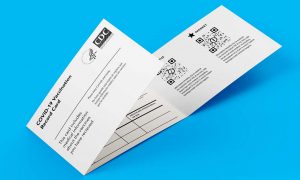
Apart from Israel and the United Arab Emirates, the distribution of the COVID-19 vaccine hasn’t been smooth. The United States has been chaotic since the vaccines were approved. A lot of people in the U.S. have been hustling for ephemeral appointment slots and pharmacies are aiming to finish their leftover doses before their expiration date.
An MIT-led coalition has revealed an augmented vaccination card that may work with or without user apps to help ensure a smoother vaccination process for everyone.
The most basic form of the vaccination card would include QR codes that can be applied as stickers to existing cards already distributed by the U.S. Centers for Disease Control. These codes would possess encrypted digital information required for each stage of a person’s vaccination process which can be scanned by the authorities to check the person’s status. It would also avoid collecting personal information to avoid breaching privacy.
‘We should start sending these unique vaccination cards to everybody right now, like a mail-in ballot or census form’, said Ramesh Raskar, Associate Professor of Media Arts and Sciences at the MIT Media Lab.
The current state of the US vaccination process is due to their lack of federal-state coordination on the supply chain. A bit different from the distribution of the flu vaccine distributed every year, the COVID-19 vaccine has to be doled out to the most vulnerable people first. There is also the need to follow up the first dose with a second dose, while ensuring the second dose matches what was used in the first dose.
The MIT team is of the opinion that their vaccination card could help hasten things up by getting rid of the paperwork needed to check on eligibility and status at vaccination sites like pharmacies and clinics. It would give workers more time to focus on vaccinating the people after scanning the card’s QR code. The MIT-led coalition including the MIT-spinoff nonprofit PathCheck Foundation and IDEO, the global design company— presented its work in a video conference held on 26th Jan 2021.
Each person would start by receiving a ‘coupon’ QR code from their employer or city officials. It would contain only a coupon number with the CDC’s digital signature, coupled with information such as job and zip code so restrict the coupon’s usage to a particular geographical area.
Next, the person would present the coupon QR code for scanning at a vaccination site to get vaccinated. The coupon would be scanned to verify the CDC’s digital signature before giving the first dose of the vaccine.
‘The beauty of this is you let the logistics people do the logistics, and you let the issuing authority give you your coupon independently, and each can do it in a decoupled way’, said Sanjay Sarma, Professor of Mechanical Engineering and Vice President for Open Learning at MIT. He had in mind a process to operate large mass vaccination sites in a non-stressful way.
The worker would then use the system to update the person’s status and generate a ‘badge’ QR code for the person. That badge QR code would be based in part on personally identifying information, like the person’s name would be hashed in order to generate a random and unique digital passkey.
The status and passkey information would be sent to a CDC server for the badge verification, which indicates the CDC never acquires the personal information. But the CDC may still track the statistics of the amount of people getting vaccinated across the country. The badge QR code could also be helpful for any future events regarding vaccination and the CDC.
‘At the first stage, you have proof of eligibility, then you have proof of full vaccination, and if you potentially have symptoms you’re submitting to the system are related to the relevant vaccine’, said Anna Lysyanskaya, Professor of Computer Science at Brown University and a member of the coalition.
This process would be repeated when the person goes back for the second dose. The vaccination card’s QR code can serve as a health passport to display a person’s vaccination status when entering public facilities or boarding a flight.
The vaccination card could also possibly work in conjunction with a Boost19 app, being developed by the PathCheck Foundation. This app would accommodate more useful health-related information than what fits in a QR code, helping to verify the person’s credentials during each check and helping to report side effects, if any.
However, the paper-only vaccination has its advantages, as it could coordinate people with no online presence or smartphones.
This isn’t the only tech coalition aiming to help with the vaccination process. Some other participants of the MIT video conference included speakers from external groups such as Vaccine Credential Initiative, as well as companies such as Microsoft, Oracle and Salesforce. Their aim is to create a digital certificate standard to assist people in accessing their digital vaccination records through iOS and Android phones.
Another presentation studied the digital credentials approach currently in development by the COVID-19 Credentials Initiative supported by the Linux Foundation Public Health, which includes corporate members such as Cisco, IBM and Tencent.
It is yet to be seen if any of these proposals get accepted by the authorities involved in the U.S. vaccine distribution. Considering the intricacies of the vaccination process, any approach to reduce the chaos and make the process simpler will be very helpful.
By Marvellous Iwendi.
Source: IEEE Spectrum